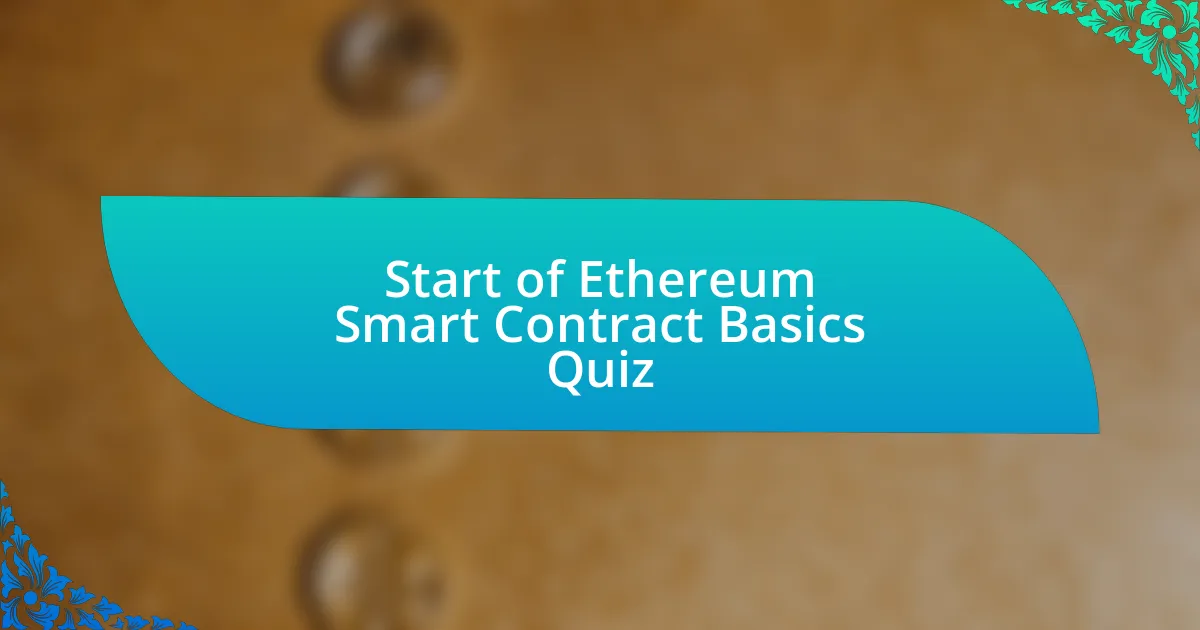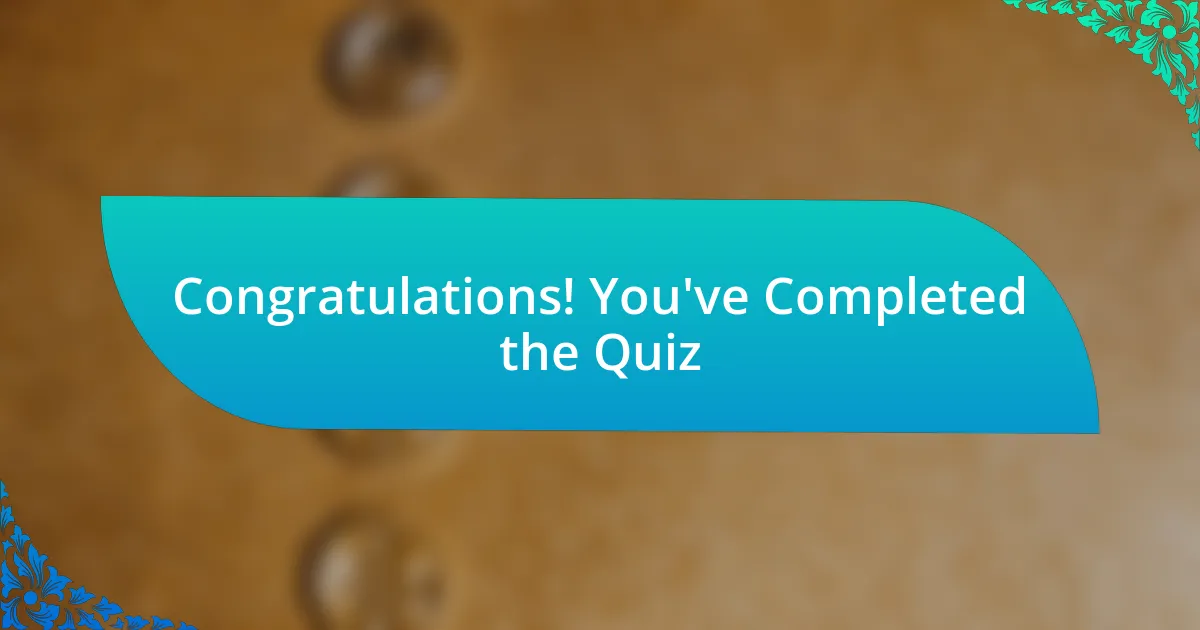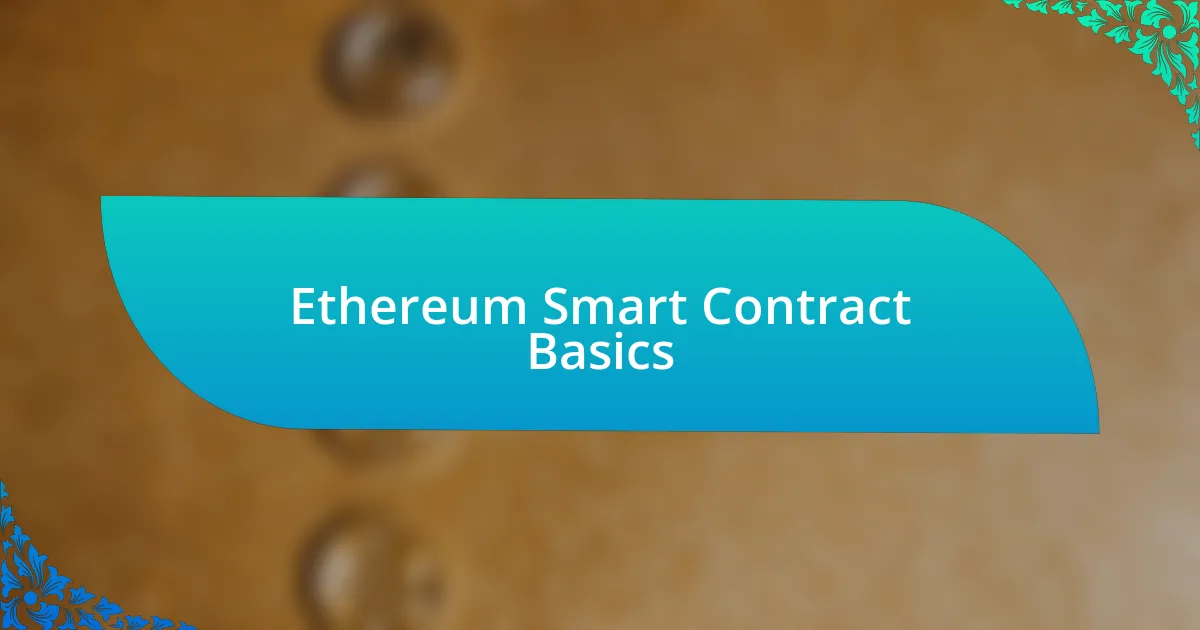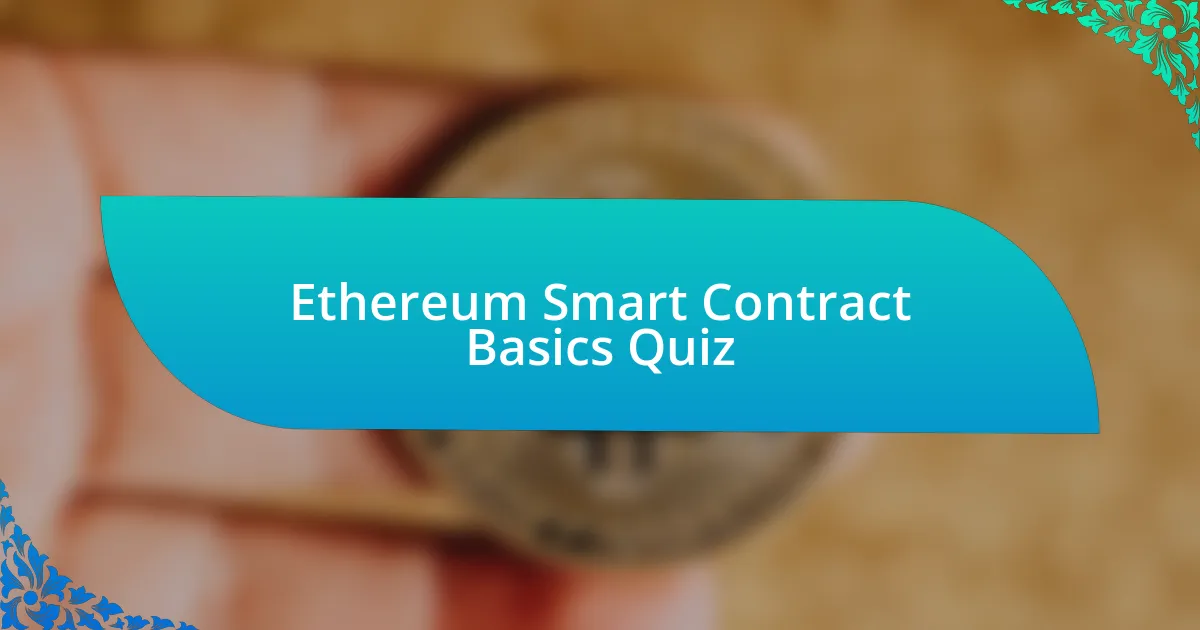
Start of Ethereum Smart Contract Basics Quiz
1. What is the primary function of a smart contract?
- To print copies of a contract for legal purposes.
- To serve as a physical representation of a contract.
- To manually negotiate contract terms between parties.
- To execute the terms of a contract automatically after specific conditions are met.
2. What technology serves as the foundation for smart contracts?
- Data storage systems.
- Cloud computing platforms.
- Blockchain technology.
- Traditional databases.
3. How are transactions verified and recorded in a blockchain?
- By a central authority approving each transaction.
- By using traditional banking systems to confirm transactions.
- Through random selection of transactions to process.
- Through a consensus mechanism by multiple nodes in the network.
4. What is the purpose of the Ethereum Virtual Machine (EVM)?
- To execute smart contracts according to the rules programmed by developers.
- To create new cryptocurrencies for trading.
- To store user data securely on the blockchain.
- To manage user identities and access permissions.
5. In which programming language are smart contracts typically written?
- Solidity
- Ruby
- Java
- Python
6. What is the nature of Solidity in relation to JavaScript?
- Solidity is a low-level, assembly language used for blockchain coding.
- Solidity is a database management system designed for JavaScript integration.
- Solidity is a game development framework that relies on JavaScript syntax.
- Solidity is a high-level, object-oriented language similar to JavaScript.
7. What are the key components of a smart contract?
- Coding, conditions, and execution.
- Data encryption, approval process, and verification.
- Manual intervention, user agreements, and logging.
- User interface, transaction fees, and processing speed.
8. How are smart contracts deployed onto the blockchain network?
- Using cryptography encryption.
- Through HTTP requests.
- Via physical delivery methods.
- By email transmission.
9. What happens when predefined conditions are met in a smart contract?
- The smart contract reverts to the initial state.
- The smart contract needs manual approval to proceed.
- The smart contract fails to operate entirely.
- The smart contract automatically executes the terms of the agreement.
10. How does the blockchain network validate the execution of a smart contract?
- By requiring users to manually approve each transaction on the network.
- By checking if the smart contract is written in Solidity language.
- By ensuring that the terms of the agreement have been met and that the transaction is valid.
- By confirming the identity of the contract creator using multi-signature.
11. What is the result of a transaction being validated in a smart contract?
- The transaction is recorded on the blockchain as an immutable record.
- The transaction is sent back to the sender for approval.
- The transaction is reversed and not recorded.
- The transaction is deleted from the blockchain permanently.
12. How do smart contracts settle transactions?
- By verbally confirming each transaction with the users involved.
- By manually approving transactions through centralized authorities.
- By transferring the agreed-upon assets or funds to the respective parties.
- By issuing paper contracts for all parties involved.
13. What is the role of the Ethereum Virtual Machine (EVM) in smart contract execution?
- The EVM only validates smart contracts without executing them.
- The EVM stores all data related to smart contracts permanently.
- The EVM manages transaction fees for users in Ethereum.
- The EVM compiles smart contracts into bytecode for execution on the blockchain.
14. What are the common data types in Solidity?
- DECIMAL, lists, and pointer
- FLOAT, characters, and variable
- UINT, strings, and address
- LONG, arrays, and object
15. How do smart contracts handle data storage?
- Smart contracts only use temporary memory for data storage.
- Smart contracts use storage, transient storage, memory, and the stack for data storage.
- Smart contracts do not handle data storage; they rely on user input only.
- Smart contracts store all data on external servers.
16. What is the difference between storage and transient storage in smart contracts?
- Storage requires additional gas fees, while transient storage does not incur any costs.
- Storage is only accessible by the contract owner, while transient storage is open to all users.
- Storage is persistent between function calls and transactions, while transient storage is reset at the end of each transaction.
- Storage is temporary, while transient storage is permanent after execution.
17. How does memory work in smart contracts?
- Memory allows for unlimited read and write operations without byte restrictions.
- Memory is structured in hierarchical layers and has no size limits.
- Memory is linear and can be addressed at a byte level, but reads are limited to a width of 256 bits.
- Memory is accessed only through external calls from other contracts.
18. What happens if a contract creation transaction does not have a recipient?
- The transaction creates a new contract with an address derived from the sender and its number of transactions sent.
- The contract is sent to a null address, causing it to disappear.
- A regular transaction occurs, ignoring the contract creation.
- The transaction fails and is reversed automatically.
19. How are functions in a smart contract accessed?
- Functions can only be accessed by their hash value.
- Functions can only be accessed from external contracts.
- Functions must be called through a complex indexing system.
- Functions can be accessed directly via their name without the `this.` prefix.
20. What is the purpose of the `require` statement in a smart contract?
- To encrypt sensitive information within the contract.
- To transfer ownership of the smart contract.
- To permanently store data on the blockchain.
- To ensure that specific conditions are met before executing a function call.
21. How does a smart contract handle errors?
- Smart contracts automatically fix any errors encountered during execution.
- Smart contracts log errors for future review but do not affect execution.
- Smart contracts ignore errors and continue executing all transactions.
- Smart contracts use `require` statements to revert all changes if certain conditions are not met.
22. What is the role of the `msg.sender` variable in a smart contract?
- `msg.sender` is the total balance of the contract.
- `msg.sender` is the address where the current external function call came from.
- `msg.sender` is the previous block`s hash.
- `msg.sender` is the gas cost of the transaction.
23. How can a smart contract be tested before deployment?
- Smart contracts can be tested using a centralized server for efficiency.
- Smart contracts can be tested only through manual debugging in the programming environment.
- Smart contracts can be tested on an Ethereum Testnet to ensure they function as intended.
- Smart contracts can be tested by deploying them on the mainnet immediately.
24. What is the significance of immutability in smart contracts?
- Immutability means that the contract must be rewritten if changes are needed.
- Immutability only protects the contract`s code, not the data it processes.
- Once a smart contract is posted on the blockchain, it becomes an immutable record where tampering is easily detected.
- Immutability allows for contracts to be edited easily if errors are found.
25. How do oracles provide data to smart contracts?
- Oracles restrict data access to only a few smart contracts for security.
- Oracles manually enter data into smart contracts using forms.
- Oracles use physical documents to inform smart contracts about external events.
- Oracles provide `trusted` data to smart contracts through transactions, allowing them to perform actions based on approved data.
26. What is the purpose of whitelisting in smart contracts?
- Whitelisting allows only approved entities to interact with the smart contract.
- Whitelisting sets a price list for services offered by the contract.
- Whitelisting generates random hash values for transactions.
- Whitelisting establishes time limits for contract execution.
27. How can the integrity of a smart contract be ensured?
- Programming in multiple languages.
- Ignoring potential vulnerabilities.
- Testing the code in an Ethereum Testnet.
- Using traditional legal contracts.
28. What is the difference between internal and external functions in Solidity?
- Internal functions can only read data, while external functions can write data.
- Internal functions can be invoked from inside the contract, while external functions can be called from any contract.
- Internal functions are private, while external functions are public only.
- Internal functions are for state changes, while external functions handle logging.
29. How do smart contracts handle array operations?
- Smart contracts can only append elements to arrays without deletion.
- Smart contracts handle arrays by using external storage only.
- Smart contracts cannot perform any operations on arrays.
- Smart contracts can delete elements from arrays using functions like `delete` or `reduction of length`.
30. What is the significance of unit testing in smart contract development?
- Unit testing is used to improve the user interface of smart contracts.
- Unit testing guarantees that no bugs exist in the smart contract.
- Unit testing helps check whether a smart contract works as intended by testing its different components.
- Unit testing allows developers to deploy contracts directly on the mainnet.

Congratulations! You’ve Completed the Quiz
Thank you for participating in the quiz on ‘Ethereum Smart Contract Basics.’ We hope you found it both enjoyable and enlightening. Engaging with the questions allowed you to explore fundamental concepts, such as what smart contracts are and how they function within the Ethereum ecosystem. As you answered each question, you uncovered key insights that can empower your understanding of blockchain technology.
Through this quiz, you likely gained a clearer perspective on the pivotal roles smart contracts play in decentralized applications. You may have learned about their programmability, automation features, and the security risks associated with them. This foundational knowledge is essential for anyone looking to delve deeper into Ethereum and its vast potential.
We invite you to continue your learning journey! Please check the next section on this page, where we have curated detailed information that further expands on ‘Ethereum Smart Contract Basics.’ Deepening your knowledge will enhance your capacity to innovate and engage with this transformative technology. Happy learning!

Ethereum Smart Contract Basics
What is Ethereum?
Ethereum is a decentralized, open-source blockchain system that features smart contract functionality. It serves as a platform for developers to build and deploy decentralized applications (dApps). Ethereum was proposed by Vitalik Buterin in late 2013 and went live in 2015. Unlike Bitcoin, which primarily serves as a digital currency, Ethereum aims to facilitate programmable transactions through its unique architecture. This programmability is made possible by its native currency, Ether (ETH), which is used to pay for transaction fees and computational services on the network.
Understanding Smart Contracts
Smart contracts are self-executing agreements with the terms of the contract directly written into code. Ethereum allows these contracts to be executed on its blockchain, ensuring transparency and security. They automatically enforce and execute terms when predetermined conditions are met. This eliminates the need for intermediaries, reducing costs and risks of fraud. Smart contracts are immutable once deployed, meaning they cannot be altered, which reinforces trust in automated transactions.
How Smart Contracts Work on Ethereum
Smart contracts on Ethereum are written in programming languages like Solidity. When a smart contract is deployed, it resides at a specific address on the Ethereum blockchain. When users interact with the contract, they send transactions to its address, which triggers the execution of the associated code. The contract processes inputs, performs functions defined within it, and updates the blockchain state accordingly. This process is tracked by all network participants, ensuring accountability and verification.
Advantages of Ethereum Smart Contracts
Ethereum smart contracts offer several advantages, such as reduced reliance on intermediaries and lower transaction costs. They enhance trust between parties by utilizing encryption and immutable records. Additionally, they can operate 24/7 without downtime or human error. These features make transactions faster, more efficient, and cost-effective for a variety of applications, from financial services to supply chain management.
Real-World Applications of Ethereum Smart Contracts
Ethereum smart contracts are employed across various sectors. In finance, they enable decentralized finance (DeFi) applications, offering services like lending and borrowing without traditional banks. They are also used in supply chain management to automate tracking and verification processes. In the entertainment industry, smart contracts facilitate digital rights management. These applications showcase the versatility and transformative potential of Ethereum’s smart contract technology.
What is an Ethereum Smart Contract?
An Ethereum Smart Contract is a self-executing contract with the terms of the agreement directly written into code. It runs on the Ethereum blockchain, enabling trustless transactions without intermediaries. Smart contracts ensure that once the predetermined conditions are met, the contract automatically enforces and executes the agreement. This functionality is backed by the Ethereum platform, which uses a decentralized network to provide security and transparency.
How do Ethereum Smart Contracts work?
Ethereum Smart Contracts work by utilizing a set of rules encoded in the Ethereum Virtual Machine (EVM). When deployed, the contract is given its own address on the blockchain, allowing users to interact with it through transactions. Once the input conditions are met, the EVM processes the contract, executing the code and updating the blockchain with any changes or state modifications. This process ensures that all interactions are immutable and publicly verifiable.
Where are Ethereum Smart Contracts stored?
Ethereum Smart Contracts are stored on the Ethereum blockchain. When a smart contract is deployed, its code and state are recorded on the blockchain, making it accessible and immutable. This decentralized storage ensures that the smart contract can be interacted with by anyone on the network, providing transparency and security in its execution.
When were Ethereum Smart Contracts introduced?
Ethereum Smart Contracts were introduced with the launch of the Ethereum blockchain on July 30, 2015. The introduction of smart contracts revolutionized the concept of decentralized applications (dApps) by allowing developers to create rules that could be executed automatically on the blockchain, enhancing the efficiency of transactions and decentralized services.
Who developed Ethereum Smart Contracts?
Ethereum Smart Contracts were developed by Vitalik Buterin, who co-founded the Ethereum platform. Buterin proposed the Ethereum protocol in late 2013 as a way to extend the blockchain’s capabilities beyond just cryptocurrency transactions. His vision enabled developers to create decentralized applications using smart contracts, leading to the current ecosystem of dApps that utilize this technology.

